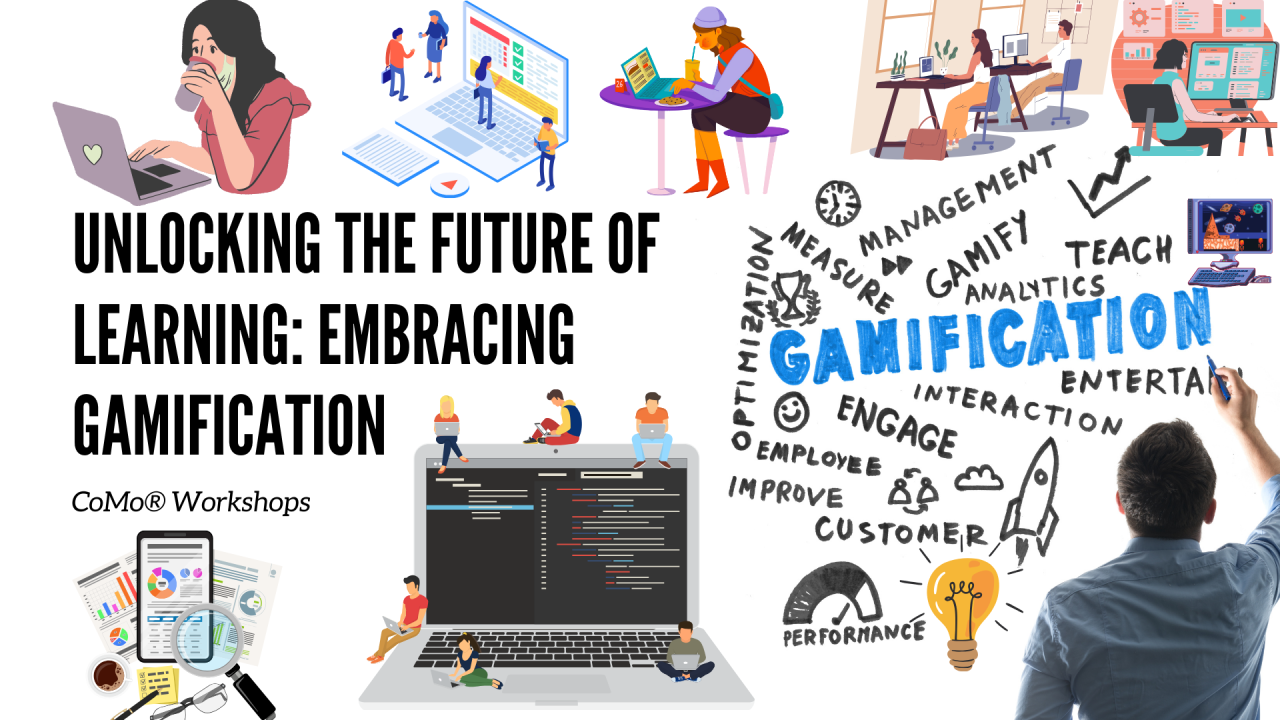Unlocking the Power of Gamification: Why Educators Should Embrace Gamified Learning Platforms

Attention all educators! Are you tired of hearing the sound of disinterest coming from your students? Well, it’s time to turn up the volume on engagement and unlock the power of the Gamification Platform in education! In this digital age, where gaming has taken centre stage in our lives, why not harness its captivating nature to create an unforgettable learning experience? Join us as we delve into the world of gamified learning platforms and discover how they can revolutionise education for both teachers and students. Get ready to level up your teaching game – trust us, you won’t want to miss out on this exhilarating journey!
Introduction to Gamification and its use in education
Gamification is a concept that has gained significant popularity in recent years, especially in the field of education. It involves the integration of game-design elements and principles into non-game contexts such as learning environments, with the aim of making them more engaging, interactive and enjoyable.
The idea behind gamification is rooted in the understanding that humans are naturally drawn to challenges, competition and rewards. By incorporating these elements into educational settings, educators can tap into students’ intrinsic motivation and drive for achievement, thereby enhancing their learning experience.
The use of gamified learning platforms has become increasingly prevalent in schools, colleges and universities across the globe. These platforms can take various forms such as digital games, simulations, quizzes and puzzles. They are designed to create an immersive learning experience by providing students with a sense of autonomy, mastery and purpose – essential components for effective learning.
One of the primary benefits of using gamification in education is that it makes learning more fun and enjoyable for students. Instead of passively receiving information through lectures or textbooks, students become active participants in their own learning process. This not only increases their engagement but also leads to better retention and understanding of concepts.
Moreover, gamified learning platforms provide immediate feedback to students on their progress through points, levels or badges – just like how video games reward players for completing tasks. This constant feedback loop keeps students motivated to continue challenging themselves and improving their performance.
Another advantage of gamification is its ability to cater to different learning styles and preferences. As students have different interests and strengths, a gamified learning environment allows them to choose activities that align with their individual needs and learning styles. For example, a student who enjoys problem-solving may be more inclined to engage with a puzzle-based game, while another student who prefers visual aids may find simulations more appealing.
In addition, gamification can promote collaboration and social interaction among students. Many educational games are designed for multiplayer participation, allowing students to work together towards a common goal, share knowledge and learn from each other.
However, it is crucial to note that gamification should not be seen as a replacement for traditional teaching methods. Instead, it should be used as a supplement to existing instructional techniques. Effective implementation of gamification in education requires careful planning and integration into the curriculum to ensure its alignment with learning objectives.
Gamification has the potential to transform education by making learning more engaging, interactive and personalised for students. By tapping into students’ natural inclination towards challenges and rewards, educators can create an immersive learning experience that fosters motivation and achievement.
Benefits of using Gamification in the classroom
Gamification is a powerful tool that has been gaining popularity in the field of education. It involves incorporating game elements and mechanics into non-game settings, such as the classroom, to motivate and engage students in their learning. This approach to learning has proven to be highly effective, with numerous benefits for both students and teachers.
1. Increased Motivation and Engagement: One of the main benefits of using gamification in the classroom is that it increases student motivation and engagement. By incorporating game-like elements, such as points, levels, badges, and leaderboards, students are incentivized to participate actively in their learning. They become more invested in their progress and are more likely to take on challenges and complete tasks with enthusiasm.
2. Personalised Learning Experience: Gamification allows for a personalised learning experience for each student. As games are designed with different levels of difficulty, students can progress at their own pace without feeling overwhelmed or bored. This ensures that all students are challenged appropriately, leading to better retention of information.
3. Instant Feedback: Gamified learning platforms provide instant feedback on student performance through points and scores displayed on leaderboards or through unlocking new levels or achievements. Students receive immediate gratification for completing tasks correctly or mastering a specific skill, which helps boost their confidence and motivation.
4. Encourages Collaboration: Many gamified learning platforms include social features that encourage collaboration among students. These features allow students to work together towards common goals or compete against each other in a friendly manner. This fosters teamwork and communication skills, which are essential for success in the real world.
5. Makes Learning Fun: By incorporating game-like elements, learning becomes more fun and engaging for students. This helps create a positive learning environment where students are excited to come to class and participate actively in their education. It also helps reduce stress and anxiety associated with traditional classroom settings.
6. Builds Skills and Knowledge: Gamification can be used to teach a variety of subjects, from maths and science to language arts and history. Through game-based activities, students can develop critical thinking, problem-solving, decision-making, and other important skills while acquiring new knowledge.
7. Increases Retention: Studies have shown that gamification can improve information retention among students. By making learning more interactive and enjoyable, students are more likely to remember what they have learned long-term. This is especially beneficial for complex or abstract concepts that may be challenging for some students to grasp.
8. Encourages Healthy Competition: Gamification introduces an element of healthy competition among students, motivating them to work harder and achieve better results. This can help improve student performance as they strive to outdo each other in a friendly manner.
9. Provides Data for Assessment: With gamified learning platforms, teachers can track student progress and performance in real-time. This data can be used to identify areas where students are struggling and provide targeted support to help them improve. It also helps teachers make informed decisions about their teaching methods and curriculum.
10. Prepares Students for the Future: With technology becoming increasingly prevalent in our daily lives, incorporating gamification in education prepares students for the future. It helps develop their digital literacy, problem-solving skills, and adaptability, which are essential for success in the 21st century workplace.
Case studies and success stories of Gamified learning platforms
Gamified learning platforms have been gaining popularity in recent years due to their ability to engage and motivate students in the learning process. But what makes them so effective? In this section, we will delve into case studies and success stories of schools and educational institutions that have implemented gamified learning platforms with great results.
Case Study 1: Kahoot!
Kahoot! is a game-based learning platform that allows teachers to create interactive quizzes, surveys, and discussions for their students. The platform uses points, leaderboards, and rewards to encourage healthy competition among students. A study conducted by researchers from the University of Oslo found that using Kahoot! as a teaching tool increased student engagement by 37%, improved test scores by 26%, and reduced disruptive behaviour in the classroom.
Success Story: Forest Trail Academy
Forest Trail Academy is an online school that offers K-12 education through a virtual platform. To increase student participation and motivation, they incorporated gamification elements such as badges, progress bars, levels, and points into their curriculum. As a result, they saw a significant improvement in student retention rates – from 65% to 95%. Moreover, students reported feeling more motivated and engaged in their coursework.
Case Study 2: Classcraft
Classcraft is an online role-playing game designed for classrooms where students take on different roles such as mage or warrior. They earn experience points (XP) for completing assignments or participating in class activities which can be used to level up their characters. A study conducted by the University of Michigan found that using Classcraft resulted in a 38% increase in students’ academic performance and a 90% decrease in disruptive behaviours.
Success Story: Georgia State University
Georgia State University used Classcraft as part of their remedial maths program for their first-year students. The goal was to improve student engagement and retention rates in the course. After implementing Classcraft, they saw a significant improvement in attendance, participation, and grades. The pass rate for the course increased from 64% to 75%, and students reported feeling more motivated and invested in their learning.
Case Study 3: Duolingo
Duolingo is a language-learning platform that uses game elements such as points, streaks, and rewards to motivate users to continue learning. A study conducted by the City University of New York found that using Duolingo for just one semester resulted in an average score improvement of 80% on standardised language tests.
Success Story: San Francisco Unified School District
San Francisco Unified School District incorporated Duolingo into their high school Spanish curriculum with the goal of increasing student engagement and motivation. They found that students who used Duolingo had higher attendance rates, lower absenteeism, and improved test scores compared to those who did not use the platform.
These case studies and success stories demonstrate the effectiveness of gamified learning platforms in increasing student engagement, motivation, and academic performance. With the right implementation and integration into the curriculum, gamification can be a powerful tool for enhancing the learning experience for students of all ages.
Conclusion: Embracing Gamified Learning Platforms for Effective Education
Gamification has proven to be a powerful tool in enhancing education and engaging students in the learning process. With the rise of technology and the increasing use of digital platforms in education, educators have an opportunity to embrace gamified learning platforms for effective teaching.
One of the key benefits of using gamification in education is its ability to foster engagement and motivation among students. By incorporating game elements such as points, levels, and rewards into the learning process, students are more likely to stay engaged and motivated to complete tasks and challenges. This can lead to increased participation and a deeper understanding of the subject matter.
Moreover, gamified learning platforms offer a personalised learning experience for each student. With features such as adaptive learning and progress tracking, these platforms can tailor content and activities based on individual student needs and abilities. This not only helps students learn at their own pace but also provides them with a sense of autonomy over their learning journey.
Another advantage of embracing gamified learning platforms is that it creates a more interactive and immersive learning environment. Instead of passively consuming information, students are actively involved in problem-solving, decision-making, and critical thinking – all essential skills for success in today’s world. Through games, simulations, and other interactive activities, students can apply their knowledge in real-world scenarios while having fun.
Furthermore, gamification promotes healthy competition among students. By introducing leaderboards or challenges within the platform, students can compete against each other in a friendly and productive manner. This not only encourages students to work harder but also fosters a sense of community and collaboration.
In addition, gamified learning platforms can help educators track student progress and identify areas where students may be struggling. This data can then be used to provide targeted support and interventions to ensure that all students are able to succeed.
In conclusion, gamified learning platforms offer numerous benefits for effective education. By incorporating game elements into the learning process, educators can create a more engaging, personalised, and interactive learning experience for their students. As technology continues to advance, it is essential for educators to embrace these innovative tools in order to prepare students for the ever-changing digital landscape.
Leave a Reply
You must be logged in to post a comment.



Leave a Comment